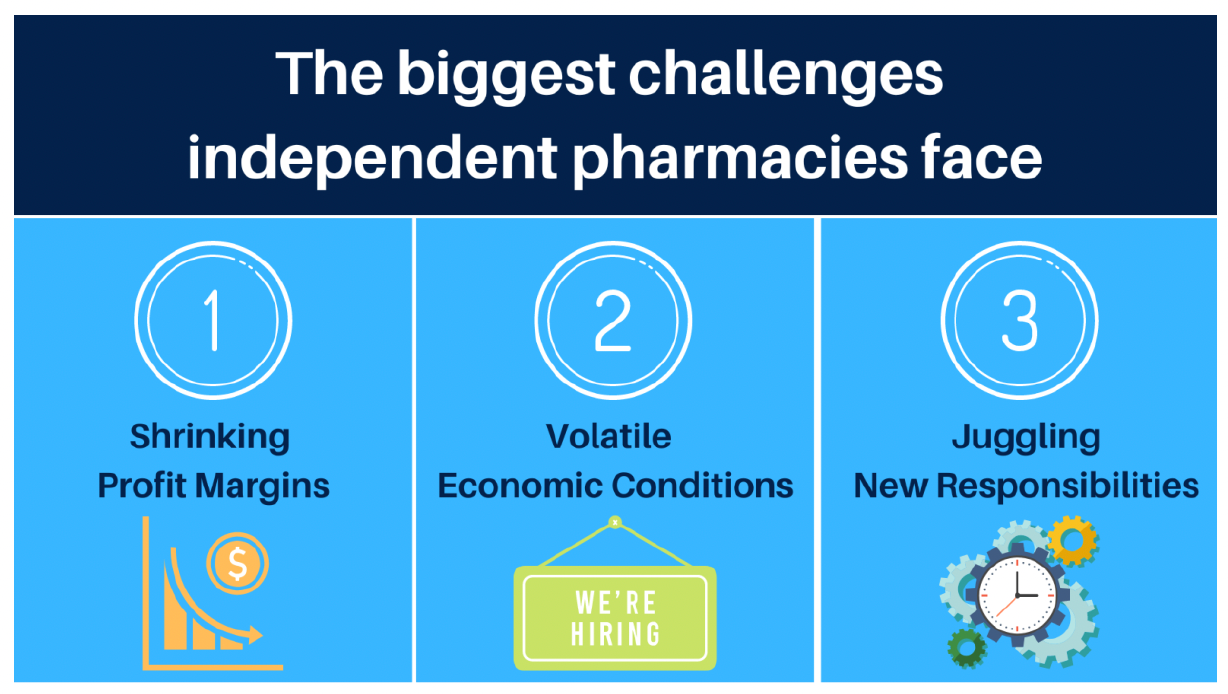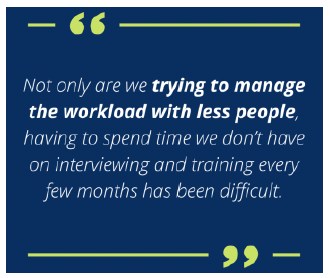Overcoming the 3 Biggest Challenges Independent Pharmacies Face Today
A few years ago, an independent pharmacy’s biggest threat was competing with larger, retail chains. The “big box” stores ignited a shift in the industry, introducing consumers to many of the conveniences they have now come to expect – from extended hours and online refill requests to prescription alerts and flexible delivery options. To keep up, some independent pharmacies began exploring ways to automate their operations, however, many continued to utilize their existing, manual workflows. Fast forward to today, where independent pharmacies are faced with a whole new set of challenges. Not only are they fighting to keep their customers, but they are struggling to overcome several threats to their bottom line as well. In fact, competing with corporate chains has become the least of their worries. Now, the three biggest challenges for independent pharmacies are:

Challenge #1: Shrinking profit margins
It’s no secret that PBMs have been chipping away at pharmacy reimbursements for years. PBMs not only have the power to decide which drugs are covered by an insurance provider, but their prices as well. In fact, the three biggest PBMs control nearly 80% of the medicine market. While PBMs profits have continued to grow, pharmacy reimbursements are steadily declining. Plus, the rising out-of-pocket costs have many patients reaching prescription discount cards, which impacts a pharmacy’s bottom line even further.

According to Manatee Discount Pharmacy Manager, Hamad Nawaz, PharmD., RPh, they are constantly searching for ways to offset their shrinking margins. Not only have they been expanding their services to bring in additional revenue, but they’re focused on ways to streamline their operations as well.
The Solution: Independent pharmacies need to review their margins and other performance metrics regularly to ensure they are operating as efficiently and cost-effectively as possible. Pharmacies can save a substantial amount of time and money just by automating manual processes within their daily workflow. In fact, pharmacies who utilize pharmacy management software to submit their claims electronically avoid many (often costly) mistakes made due to human error. Pharmacy software also provides pharmacies access to auditing tools that helps to:
- Validate prescription benefits electronically, reducing paper clutter and time spent on calls
- Quickly address claim errors and avoid switch/restocking fees
- Maximize reimbursements and easily track claims to ensure payment is received
Challenge #2: Volatile economic conditions
The current economic conditions are no better. Ongoing supply chain issues have caused product demand and pricing to soar. Inflation is affecting everything from pharmacy supplies and shipping to support services and staffing, making it increasingly more expensive to operate a pharmacy.
In fact, attracting (and retaining) staff has been especially difficult in recent years. Not only is it harder and more time consuming to find qualified candidates, but many pharmacies have become a revolving door of employees. Rising labor costs, having to constantly focus on recruitment and working short staffed has placed an additional burden on the pharmacy.
“Even offering very competitive wages, our pharmacy has struggled to stay fully staffed in recent years,” says one pharmacy owner. “Not only are we trying to manage the workload with less people, having to spend time we don’t have on interviewing and training every few months has been difficult to manage.”

The Solution: Now more than ever before, pharmacies need to ensure they’re maximizing their resources. Pharmacies can transition many of the time-consuming, repetitive tasks within their daily workflow to be done automatically using pharmacy software. In fact, using features like BestRx’s AutoProcess and NightTech can process scripts automatically behind the scenes – even afterhours. Together, these advanced features provide pharmacies with around-the-clock support, including:
- Verifying designated prescription queues
- Submitting claims to payors
- Billing copays to A/R
- Printing prescription labels
During normal pharmacy hours, AutoProcess can be used for specific patients, or for all scripts within a particular queue. This frees the pharmacy’s staff to focus on other tasks and process multiple prescriptions at once – even when they’re short staffed.
After hours, the pharmacy can enable NightTech to continue verifying prescriptions within selected queues overnight. With claims submitted and labels printed, the pharmacy can begin filling scripts the moment they walk in the door in the morning.

“Having the ability to continue to work through prescription requests after hours has drastically decreased our morning workload,” the pharmacy owner states. “Being able to automate several steps in our fulfillment process has helped to shift work off of our staff.”
Challenge #3: Navigating their expanded role in patient care
On top of all of it all, a pharmacist’s role has grown in recent years. In addition to dispensing medications and providing administration and safety information to patients, pharmacists are now more directly involved in:
- In-depth patient education
- Monitoring medication adherence & other safety metrics
- Care team collaboration
- Administering vaccines and other point-of-care testing
This means pharmacists who were stretched thin before are juggling even more responsibilities. This creates the perfect storm for independent pharmacies. Their growing to-do list is compounded by the recent labor shortages and inflation pressures that are threatening their already shrinking margins.
The Solution: To keep up with the increased demands, pharmacies will need to find ways to remove some of their workload, without sacrificing care. For example, one of the most time-consuming tasks for any pharmacy is patient communication. Pharmacists and staff spend countless hours on the phone each day that could be spent on other critical tasks. The right pharmacy software can help busy pharmacies streamline their patient communications and save valuable time.
Using BestRx’s Messaging Interface, pharmacies quickly communicate with patients by email or text. The electronic messages can be used to communicate general pharmacy information to a large group of patients, or for patient-specific prescription alerts. Patients can even respond back using the 2-way chat feature or submit refill requests online.
The ongoing staffing shortages are especially difficult for multi-store owners, making managing mounting prescription queues across all their locations a daunting task. Central Verification is another innovative software feature designed to help multi-pharmacy owners maximize their pharmacist’s time by providing access to each store’s verification queue under a single account. This means a single pharmacist can quickly verify scripts for multiple pharmacies through a convenient online portal.
“Having the ability to continue to work through prescription requests after hours has drastically decreased our morning workload,” the pharmacy owner states. “Being able to automate several steps in our fulfillment process has helped to shift work off of our staff.”
The Bottom Line: Pharmacies that were putting off automating their pharmacy can no longer afford to do so.
While investing in pharmacy software may seem counterintuitive when trying to reduce expenses, automating manual processes significantly increases productivity and profitability. Not only does it enable pharmacies to accept prescriptions and submitting claims electronically, but it can streamline everything from the prescription verification process to how pharmacies communicate with patients. By automating its operations, an independent pharmacy can overcome these obstacles, and be best positioned to face any future challenges as well.